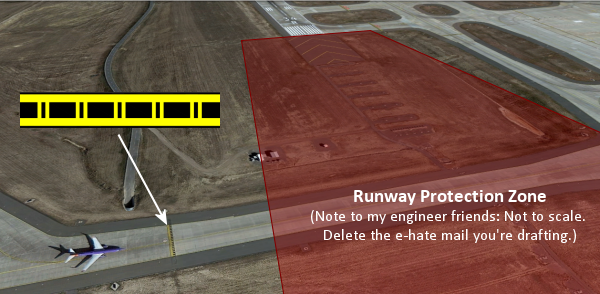Draft AC 5340-1M
By Mike Speidel
![]()
Comments have been collected from the industry for the most recent proposed changes to FAA Advisory Circular 150/5340-1. The draft of 5340-1M has likely been finalized and will be reviewed by legal. It likely will pop out the other side in its official form sometime in September/October, but here's a sneak peek at the principal changes.
Preformed Thermoplastic
Reinforces this material is "not to be used on runways because of the significantly lower friction readings recorded as compared to dry pavement."
I think most knew this to be the standard, however FAA apparently continues to receive inquiries for runway applications, so additional language will attempt to clarify (again) where performed thermoplastic markings are permitted: for a detailed description about where it can be used, click here for last issue's article.
Pattern B Holding Position Markings in Runway Approach-Departure Areas
On taxiways where aircraft may taxi under landing/departing aircraft, the standard marking to use to delineate the runway protection zone will be a Pattern B, formerly known as an ILS, holding position marking. In my experience, I have commonly seen Pattern A holding position markings used in this situation, and occasionally accompanied by enhanced taxiway centerlines despite no actual intersection with a runway.

The use of the Pattern B holding position marking is intended to reduce air traffic control and pilot workloads.I think most knew this to be the standard, however FAA apparently continues to receive inquiries for runway applications, so additional language will attempt to clarify (again) where performed thermoplastic markings are permitted: for a detailed description about where it can be used, click here for last issue's article.
No-Taxi Islands
Designed to enhance safety on taxiway routes. There are many possible applications, which I won't get into here. However, the AC does discuss common taxiing situations and existing airfield layouts in which these enhancements may be of benefit:
- Exiting Aprons
- Taxiing between aprons and entrance taxiways
- Entering Runways
As soon as the most recent AC 5340-1M is official, we'll go through it with a fine-toothed wet film gauge, and let you know what's changed and how it affects you.
On a personal note, I'd like to thank George Legarreta for his long commitment to aviation safety, and wish him the best in his retirement from the FAA Office of Airport Safety and Standards.
Jump to another article:
Spring 2017 Newsletter | Most Common Part 139 Discrepancies | Inspect & Protect | Draft AC 5340-1M | What's New?
